Final report for GNE15-098
Project Information
Soil fertility management presents the organic farmer with assorted challenges. Organic farmers generally don’t follow the typical nutrient prescription approach for fertilizing crops as their conventional counterparts do, having to respond to criteria established by the USDA National Organic Program (NOP). Instead they aim towards improving the organic matter and biological activity of soil. Often this is achieved through the use of composts, either made on farm or purchased. Yet, composting presents challenges to the farmer too, requiring considerable land base, specialized equipment, and attention to various parameters to ensure compost meets NOP standards. There are alternatives to composts that are less explored in our agricultural system; one of them is bokashi. Bokashi is produced by the fermentation of organic materials with a microbial inoculant. The concept of bokashi has East Asia origins, but has been adopted in farming communities throughout the world and is gaining recent attention in countries like the United States as a way to quickly and efficiently transform food and kitchen wastes into an effective soil fertilizer. Little is known about the characteristics and capabilities of bokashi as a soil fertility amendment. The goal of this project was to compare the use of bokashi made from food waste and Effective Microorganisms® inoculum to thermophilic compost and vermicompost as soil fertility amendments to grow spinach in greenhouse and field environments.
The greenhouse experiment showed that bokashi (B) treatments had different fertility characteristics than thermophilic compost (TC), vermicompost (V) and control treatments, especially in terms of redox reactive nutrients NO3–N -, Mn, and Fe, which is attributed to the anaerobic process used in its production. B treatments were characterized by initial high concentrations of NH4+, Mn and Fe, while V treatments were characterized by high initial NO3–N – . However, by the conclusion of the experiment, NO3–N – concentrations were greatest in B treatments, and V treatments had concentrations similar to control levels. Aboveground plant height and biomass of spinach in V and B treatments was greater than the control. This experiment suggested that B had a comparable performance to V in terms of nutrient supply and spinach growth. The field trial showed similar effects of B applications on N speciation and Mn and Fe concentrations as observed in the greenhouse experiment. Spinach from B treatments had significantly greater foliar concentrations of N, K, Mn, and Zn, as well as a significantly greater marketable yield than all other treatments at the second cutting of spinach (p<0.05). The field trial indicated that EM bokashi made from food waste may be a suitable supplemental or alternative soil fertility amendment in organic vegetable production systems. In both greenhouse and field trials, the soil microbial community in B treatments had a carbon substrate utilization pattern unique from all other treatments on the basis of principal coordinate analysis. These data suggest that bokashi applications affect the functional diversity of the soil microbial community.
In the fall of 2015 a presentation was given to UVM Farmer Training Program students to promote awareness of bokashi and its capabilities with a set of beginning farmers. In the winter of 2016 informational pamphlets on bokashi were administered from a booth at the NOFA-VT winter farming conference. A workshop was held for farmers and gardeners in August of 2016 to demonstrate how to make bokashi as well as share results from the greenhouse and field experiments. Lastly in the winter of 2017, the results of this research was shared at the MOSES conference in La Crosse, WI, the largest organic farming conference in the country.
Introduction:
Farmers will have to produce 50% more food if we are to feed “the 9 billion”. However, expanding food production is a complex problem, underlain by questions about sustainable expansion of food supply. The mining of mineral fertilizers is not a sustainable practice and increased reliance on chemicals combined with extensive cropping has caused soil and environmental degradation. In addition, prime crop land is lost to commercial and housing development, valuable topsoil to wind and water erosion, and volatile changes in climate are stressing agricultural productivity more than ever. There is an urgent need to optimize food outputs from the land without causing adverse effects on the environment or further contributing to climate change.
Organic agriculture has been recognized as a way to mitigate some of these issues. Soil fertility management presents the organic farmer with many challenges. Farmers using organic practices generally don’t follow the typical nutrient prescription approach for fertilizing their crops like their conventional counterparts, having to respond to criteria established by the USDA National Organic Program (NOP). Instead, they aim towards improving the organic matter of their soil resource, boosting biological activity, thus facilitating a slow and persistent release of nutrients to promote crop growth. Often this is achieved through the use of composts, either made on farm or purchased. Yet, composting presents challenges to the farmer too, requiring considerable land base, specialized equipment, and attention to various parameters to ensure compost meets NOP standards. However, there are alternatives to composts that are less explored in our agricultural system and one of those alternatives is bokashi.
The soil fertility amendment bokashi is being applied in agricultural systems throughout the world, yet very little is known about its characteristics and capabilities. Bokashi is produced by the fermentation of organic materials typically along with a microbial inoculant. Bokashi may address some of the challenges involved in producing composts and vermicomposts. C:N ratio is less of a concern than is with producing thermophilic composts, therefore a flexible composition of feedstock may be used. It takes a shorter period of time to make, at most two months compared to at the typical three month or longer period for composting. The initial process may require less labor, as continual turning of the bokashi is not required as is in composting and therefore expensive equipment to turn windrows is not required. Likewise the careful attention to temperature and moisture required to successfully use earthworms for composting is not needed in bokashi.
This research addresses a gap in organic soil fertility research, as this is one of the first research projects focusing on the use of bokashi in the United States. We found that bokashi was characterized by high ammonium and low nitrate content and that its application to soil improved plant growth and yield. These results advance the knowledge of bokashi regarding its fertility potential and its effects on soil. We think that this has different applications in sustainable agriculture. Food waste is the second largest component of municipal solid waste in the United States, accounting for approximately 18% of the waste stream, which is about 30 million tons every year. According to the U.S. Environmental Protection Agency, less than 3% of this waste is currently being diverted from landfills, mainly through composting. Given legislation, particularly in states like Vermont and Massachusetts that aims to reduce food waste in landfills in the future, we see bokashi being a potential way for urban dwellers to transform food waste and use it in urban agricultural farms and gardens. Also, given the results of the economic analysis, it appears that bokashi could work in smaller- scale operations, though more studies should be done.
- Objective 1: Compare the nutrient profiles of bokashi with those of high quality, commercially produced thermophilic and vermicompost.
- Objective 2: Evaluate the effect of bokashi on soil fertility and soil microbial function post application.
- Objective 3: Compare the nutrient profiles of bokashi prepared with different feedstocks.Determine the effect of bokashi amendments on the growth of spinach.
- Objective 4: Determine the effect of bokashi amendments on the growth of spinach.Determine the economic feasibility of using bokashi.
- Objective 5: Determine the economic feasibility of using bokashi.
Cooperators
- (Educator)
Research
We chose to trial bokashi in both a greenhouse and field setting using spinach as a model crop. We chose multiple environments, because we wanted to see how the bokashi behaved differently, in terms of soil nutrients and microbial activity, in a controlled (greenhouse) versus uncontrolled (field) environment. We chose spinach because we wanted to use a crop that is harvested multiple times after planting, to observe how crop and soil factors change over the course of two or more harvests.
Greenhouse Study Methods and Materials: A completely randomized design was used to test 7 treatments with 5 replications for a total of 35 experimental units. The treatments included Thermophilic Compost (TC), Vermicompost (V), Bokashi (B), each applied at two rates, 20lb N/acre and 100 lb N/acre, and a control (C) of a Windsor sandy loam soil. The data will be presented within this report referring to the treatments with letters TC, V, B for the fertility amendments followed by either 20 or 100 for the rate, with "C" representing the control. For example pots that received 20% of the nitrogen requirement via vermicompost is referred to as V 20. Amendment application rates were calculated based on total N content, factoring in the availability coefficient, based on the C:N ratio of each amendment. Due to the differences in TN and C:N of each amendment, different weights of each amendment were applied accordingly (See Table 2.1). The maximal allowable amount of Chilean nitrate to be applied to crops is 20% of the crops N need, therefore we based the two application rates on 20% and 100% of a spinach plant N requirement grown in a sandy soil (100lb N/acre or 112.1 kg/ha).
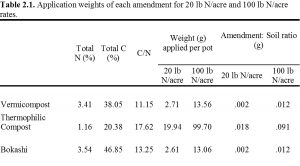
We filled square plastic pots (10 cm in width and 12 cm in depth) with approximately 1000 cm3 of field soil. The appropriate weight of amendment was applied to the soil surface and mixed into the top 8 cm. Bloomsdale Longstanding, an heirloom variety of Spinacia oleracea (spinach) with savoyed leaves was used for the experiment. Three spinach seeds, were planted 2 cm deep in each pot. Pots were placed on a bench in the University of Vermont greenhouse, where the temperature was controlled at 65˚F during the day and 55˚F during evenings. The photoperiod was set to 14 hours of light per day. Pots received 500 ml of water each upon seeding and were assumed to be at field capacity once they stopped freely draining. At this point, their weight was recorded. In the subsequent weeks, each pot was weighed twice per week and the appropriate amount of water was added to return each pot to field capacity.
Vermicompost used in the study was obtained from Worm Power (Avon, New York). The feedstock components include primarily solid dairy manure, with small amounts of silage to achieve an initial C:N ratio of 30:1. The finished product is a blend of worm castings with a C: N ration of 12:1 to 10:1. (Wormpower, Avon, NY). Thermophilic compost used in the experiments was obtained from Vermont Compost (Montpelier, Vermont). It is made up of a blend of cow, horse and chicken manure, hardwood bark, hay, silage, and some food waste. Bokashi was made at the University of Vermont, using wheat bran and food waste as feedstock in a three-part process as follows:
Part One: Bokashi Bran. Three ounces of molasses and 3 oz of Effective Microorganisms (EM-1) inoculant (TeraGanix Inc., Alta, TX) was dissolved in 1 gallon of non-fluorinated water. This mixture was added to 12 lb (5.4 kg) of wheat bran, thoroughly mixed so that contents were at field capacity, and put inside double-layered garbage bags with all oxygen removed. Contents were allowed to ferment in a dark dry place for two weeks.
Part Two: Food Waste Bokashi. Food waste was obtained from the University of Vermont food court, and processed so that no material was greater than 10 cm in width or length. Waste consisted of primarily bread and rice with some mixed vegetable and fruit scraps. All materials were thoroughly mixed to create as uniform mixture as possible. Inside 5 gallon buckets fitted with spouts, alternate layers of 5 cm of food waste and 1 cm of EM bran were arranged to the top of each bucket and compacted tightly to remove as much oxygen as possible. Buckets were left with lids on for 3 weeks, periodically draining off liquid from spouts.
Part Three: Processing and Stabilization. This intermediate product was further processed. To stabilize the amendment pH, three gallons of food waste bokashi was placed into an empty 5-gallon pail. Then Windsor loamy sand was poured in a layer on top of this to simulate burial in the field. This was repeated for three buckets total. The buckets were left for two weeks. After two weeks, 10 cores of bokashi amendment were taken from the center of the buried layer in each bucket using a soil corer. These samples were thoroughly mixed. A subsample was taken for analyses and the remainder was used for the container experiment.
Soil was sampled upon planting and at the end of the experiment from each individual container. Soil samples were dried at 55˚C, ground and passed through a 2 mm sieve, and analyzed in the laboratory for total C and N, plant available P, nitrate-N, ammonium-N, Ca, Mg, Fe, Zn, Cu, Mn and Na.
Soil data collection: Total carbon and nitrogen in soil were measured using a CN elemental analyzer (FlashEA 1112 CN Analyzer, Thermo Fisher Scientific, MA). Plant available phosphorus and Ammonia-N and Nitrate- N were measured with a Lachat Autosampler (Hach Company, Loveland, CO).
Spinach data collection: The number of seeds per pot that germinated were recorded on days 7 and 14.
Plant height was recorded on days 14, 17, 19, 21, 25 and 40. All pots were thinned to 1 plant per pot as soon as the first true leaf was observed, which varied by treatment and experimental unit. At the completion of the experiment, the entire plant in each pot was harvested and total length (TL) from root to leaf tip, root length (RL) and aboveground height (AGH) was measured and recorded. Aboveground biomass was cleaned of any soil, dried in an oven at 50˚C and weighed.
Carbon-source utilization profile data (Functional diversity of the soil microbial community): Ecoplates (Biolog Inc., Hayward, CA, USA) were used to assess the functional diversity of the microbial community adapting a method from Garland and Mills (1991). Ecoplates are 96 well microplates that contain 31 different sole carbon substrates and a water control each replicated 3 times across one plate. 1.0 g of soil was diluted 1:10 with deionized water and placed on a reciprocal shaker for 1 hour. The sample solution was diluted ten-fold and 150 µl of the resulting solution were pipetted into each well. The plates were incubated at 22˚C for 72 hours. Absorbance at 590 nm was measured at time 0, 24, 48, and 72 hours with a Model EL 311 Automated Microplate Reader (Bio-Tek Instruments Inc., Winooski, VT, USA). Biolog data was transformed and analyzed to determine which of the carbon substrates were used by soil microbes in each soil sample.
Field Study Materials and Methods: The study was conducted at the University of Vermont Horticulture Research and Education Center on a Windsor loamy sand soil on a certified organic section of the farm. The soil had an organic matter content of 3.54%, 1430.7 mg kg-1 total N, and pH in water (1:2) 6.75. The study area had been occupied by a rye cover crop which was tilled in before our experiment was established.
A completely randomized design was employed with 4 treatments TC, V, B, and Control (no fertilizer applied) with three replicates. Plot sizes were 4’ x 8’ (1.2 m x 2.4 m) with a 2’ (0.6 m) wide buffer in between each plot. TC, V, and B were applied at 100 lb of N per acre (112 kg per ha), 100% of the N requirement for spinach grown in a sandy soil. Amendment application rates were calculated based on total N content (TN), factoring in the availability coefficient, based on the C: N ratio of each amendment. Again, due to the differences in TN and C: N of each amendment, different weights of each amendment were applied accordingly (Table 2.1).
Corvair variety of Spinach were transplanted on May 14 2016 (Day 14) in three rows with 15 inch (38 cm) between row spacing and 4 inch (10.2 cm) in-row spacing. All transplants were 2.5 inches (6.4 cm) in height with a fully developed first true leaf upon transplanting. Bokashi was applied to respective treatment plots on April 30 (Day 0). Three trenches were dug in each plot using a hoe, each 8 feet (0.3 m) long, 8 inches (20.3 cm) deep and 6 inches (15.2 cm) wide, spaced according to transplant spacing. Ten pounds (4.5 kg) of bokashi were applied to each trench, filling each trench four inches high, and then backfilled with soil to achieve a level surface. This process occurred two weeks prior to transplanting so that the amendment pH could raise from its initial value of 4.2. Vermicompost and thermophilic compost were broadcast on appropriate plots and incorporated using a broad fork on May 12 (Day 12), two days prior to transplanting. Soil samples were collected on May 16 (Day 16), June 5 (Day 36), June 23, (Day 54) and July 31 (Day 92). Nine subsamples taken to a depth of 6 inches (15.2 cm) in a “W” systematic pattern in each plot using a 0.5-inch diameter tubular soil sampler, combined and thoroughly mixed. A sample of approximately 5 g was taken from that mixture to be analyzed for soil properties. 1 g was used fresh for soil Biolog assays and the remainder was dried at 50˚C for 8 hours and put through a 2 mm sieve for chemical analyses.
Spinach was harvested twice and coincided with soil sampling on Day 22 and Day 40 of the experiment. Plots were left fallow after day 40 until day 78 until the last soil sample was taken. Pegomya hyoscyami (spinach leafminer), damaged the study site prior to the first harvest. Spinach leafminer damage removes the chlorophyll from the plants, however plants will continue to produce more leaves if not overcome by the attack. For the Day 22 harvest, yields were separated into marketable and unmarketable yield, collecting all damaged parts of the plant from each plot separately from the marketable leaves of each plant. On Day 40 only marketable yield was collected, as the leafminer adults had completed their life cycle and all leaves damaged and with eggs on them had been removed during the prior harvest. Plant samples were weighed fresh and dried at
50˚C for 24 hours. Samples from marketable yield collections were ground using a coffee grinder to be further analyzed for chemical constituents.
Thermophilic compost used in the field trial was from Vermont Compost and vermicompost was from Wormpower. Bokashi was made at the University of Vermont in the Soil Sciences lab using the
two-part process detailed below:
Part One: Bokashi Bran. Three ounces of molasses and 3 oz (85 g) of Effective Microorganisms (EM-1) inoculant (TeraGanix Inc., Alta, TX) was dissolved in 1 gallon (3.8 L) of distilled water. This mixture was added to 12 lb (5.4 kg) of wheat bran, thoroughly mixed so that contents were at field capacity, and put inside double-layered garbage bags with as much oxygen removed as possible. Contents were fermented for two weeks.
Part Two: Bokashi. Food waste was obtained from the University of Vermont food court, and processed so that no material was no greater than 10 cm in width or length. Food waste consisted of primarily fruit and vegetable scraps. All materials were thoroughly mixed to create as uniform mixture as possible. Inside 5 gallon buckets fitted with spouts, alternate layers of 5 cm of food waste and 1 cm of bokashi bran were arranged to the top of each bucket and compacted tightly to remove as much oxygen as possible. Buckets were left with lids on for 3 weeks, periodically draining off liquid from spouts. The resulting product from this process was the bokashi used in the study plots. Samples of each amendment composed of 12 subsamples were collected and dried at 50˚C and sieved (<2 mm) for chemical analyses.
Soil and plant analyses were performed using the same methods as those used in the greenhouse study.
Feedstock Lab Experiment: After seeing how different food wastes vary the nutrient composition of bokashi, we decided to do another lab experiment studying 4 different types of food waste. We prepared 3 bokashi buckets for each type of food waste using the same general process as described in the greenhouse and field study methods: Two week bokashi bran preparation, followed by layering food waste with bokashi bran into 5-gallon buckets, followed by a two week fermentation period. We collected samples from each bucket to be analyzed for nutrients. The four different food wastes were:
Raw Fruit: Pineapple (50%), lemon (20%), vegetable scraps (30%)
Rice: Rice, French Fries, Green Peppers (about equal parts)
- Objective 1: Compare the nutrient profiles of bokashi with those of high quality, commercially produced thermophilic and vermicompost.
We found that bokashi that we made and used in our greenhouse experiment really varied from the bokashi we used for the field trial. The bokashi used in the greenhouse experiment was comprised of primarily bread and rice, while the field trial bokashi was comprised of mostly rice and vegetable and fruit peels, which likely contributes to the variations in C:N ratio as well as magnesium and manganese concentrations. Several preceding studies by other researchers have shown that bokashi is characterized by a high ammonium and low nitrate concentration. The results of our studies align with these findings with ammonium concentrations over 100 times those found in thermophilic compost and over 50 times those found in vermicompost.
Table 1. Nutrient profile comparison of three different types of organic soil fertility amendments.
|
TN (%) |
TC (%) |
C/N Ratio |
NH4+ -N |
NO3- -N |
TIN* |
P† |
Ca† |
K† |
Mg† |
Na† |
Al† |
Fe† |
Mn† |
Zn† |
S† |
pH |
EC (mS cm-1) |
|
|
V |
3.4 |
38.1 |
11.2 |
20.8 |
4745.0 |
4765.8 |
2705.0 |
9850 |
22250 |
4225 |
5900 |
130.5 |
- |
- |
- |
960.0 |
6.7 |
4.7 |
|
TC |
1.2 |
20.4 |
17.6 |
10.2 |
33.6 |
43.8 |
905.0 |
6900 |
4920 |
1640.0 |
1380 |
14.3 |
3.9 |
65.0 |
5.0 |
230.0 |
7.5 |
2.2 |
|
B** |
2.45 |
45.22 |
18.49 |
1055 |
40.2 |
1095.2 |
3645 |
6150 |
6250 |
1830 |
2390 |
- |
14.4 |
42.45 |
22.6 |
414 |
4.5 |
5.09 |
|
B |
3.54 |
46.85 |
13.25 |
1410 |
25.95 |
1435 |
3950 |
6400 |
8250 |
2695 |
1755 |
184 |
28.5 |
25.5 |
23.5 |
575 |
4.21 |
5.08 |
*TIN = Total inorganic nitrogen, calculated by the addition of Ammonium-N and Nitrate-N
**Bokashi used in field experiment
† Modified Morgan’s extractable element
- Objective 2: Evaluate the effect of bokashi on soil fertility and soil microbial function post application.
Since ammonium concentrations were relatively higher than the other two amendments, it makes sense that soil ammonium concentrations were significantly higher in B plots than all others at the time of transplanting. It decreases significantly by the second sample time, though is still significantly higher than all other treatments. By the third sample date there is no significant different between ammonium concentrations in any of the treatments.
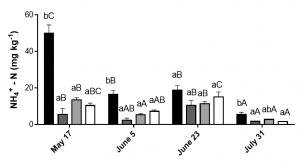
Looking at nitrate concentrations we can see that V treated plots had significantly higher levels than all the other concentrations; it has been proven in other studies that vermicompost is characterized by a high nitrate concentration. Nitrate concentrations in V plots decrease over the course of the experiment, which we attribute to leaching. However what is interesting is that nitrate concentrations in B treated plots increase, and by the third sample date are significantly greater than all other treatments. When combining nitrogen species, B plots had the highest total inorganic nitrogen left in soils at the end of the experiment, suggesting that bokashi may provide a supply of plant available nitrogen for a more prolonged period of time than vermicompost, and an earlier supply than thermophilic compost. A similar pattern was observed in the greenhouse study, whereby the greatest initial concentration of NH4+-N was observed in bokashi treatments and the highest initial concentration of nitrate in vermicompost treatments; however, concluding concentrations of soil nitrate was greatest in bokashi treatments.
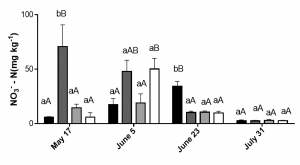
In both field and greenhouse trials, application of amendments increased plant available phosphorus concentrations in soil compared to the control plot, however further differences were not observed between B, V, and TC at any of the sample points. Other notable differences in soil fertility between treatments in both the field and greenhouse study were in concentrations of soil iron and manganese. In both studies we saw that the anaerobic and acidic nature of the bokashi improved the availability of redoxactive elements Fe and Mn in B- treated plots. In the field trial, initially B plots had a significantly higher concentration of extractable Fe in soils than all other plots. By the second sample date Fe levels in B-treated plots had dropped, which may be attributed to a combination of the occurrence of oxidation as aerobic conditions replaced by anaerobic conditions, as well as plant uptake.
Biolog Ecoplates were used to determine substrate utilization patterns by microbial communities in each treatment. We can determine differences in carbon-substrate utilization patterns by looking at a score plot made by a principal components analysis (Figure 3).
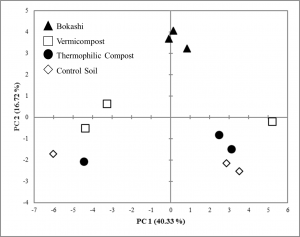
Treatment sample "scores" are represented by distinct shapes on the score plot. These scores represent carbon utilization patterns of a single sample. The closer the shapes are grouped on the plot, the more similar their utilization patterns are to one another. This plot represents soil samples taken upon transplanting in the field study. We observe that B treatments have a carbon utilization pattern distinct from all other treatments. When we analyzed the data more, we found that soil microbial communities in B treatments utilized several carbohydrates (pyruvic acid methyl ester, α-D lactose, and glycerol phosphate), two carboxylic/acetic acids (2-hydroxy benzoic acid, γ- hydroxybutyric acid), and L-threonine to a relatively greater degree than microbial communities in TC, V and C soils. B treatments continued to be separated from other treatments on the June 5 sampling, as well as on the June 23 sampling (Figures 4 and 5).
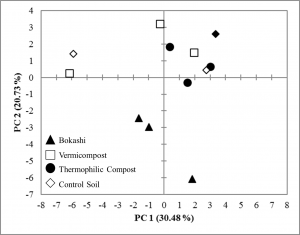
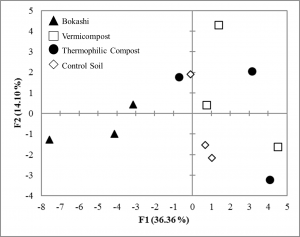
However, by the last sampling date, B treatments and TC treatments were grouped on the score plot, indicating similar carbon utilization patterns.
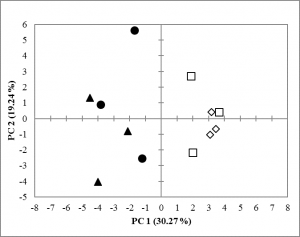
The differences in microbial functional diversity may be due to a combination of the differences in feedstock and process used in the production of each compost. The fermentation process used to produce bokashi likely selected for a microbial community unique from vermicompost and thermophilic compost, both produced aerobically. The bokashi was introduced into an aerobic environment (the soil), and left for two weeks before sampling took place, however it is possible that the community related to the anaerobic processes remained due to the feedstock of the bokashi, as well as the physical nature of the bokashi. The bokashi was made up of food waste, which has been shown in past studies to have a high fat content, creating a fat layer around materials which can inhibit aerobic respiration. This could have inhibited the microbial community of the native soil , favoring those associated with the bokashi amendment, resulting in the distinct utilization pattern in the beginning of the experiment. Bokashi also had a physical nature unlike the other amendments, as the pieces of food waste were much larger and variable in size and composition than the thermophilic compost, which is a mix of small granular pieces with larger pieces of hardwood bark, and vermicompost which is consistently fine and granular. Because of the chunkier nature of the bokashi, it seemed to absorb more water than the vermicompost and thermophilic compost, potentially creating anaerobic microsites at the depth it was buried, which causing differences in microbial community function.
- Objective 5: Determine the economic feasibility of using bokashi.
Results from the economic analysis indicate that it was not economically profitable to apply any of the amendments. The price per one kilogram (kg) of thermophilic compost and vermicompost was calculated from the bulk prices of each amendment which was $80 per cubic yard for compost and $550 per cubic yard for vermicompost, equating to $0.15 per kg and $1.35 per kg respectively.
To calculate the cost of bokashi, the cost of materials and the time it took to assemble the bran and bokashi buckets was calculated. For calculating the cost for time, we assumed a rate of paying an employee $10 per hour. The cost for materials to produce 11.3 kg of bokashi bran was $7.63, equating to $0.67 kg-1 (Table 3). The cost to produce 91 kg of bokashi used in the field trial was $32.82, which was calculated by adding the cost of producing 11.3 kg of bokashi bran ($7.63) and the amount of time it took to make the bran and assemble the buckets (2 hours), equating to a cost of $0.30 per kg of bokashi (Table 4).
Table 3. Materials cost to make 12 pounds of bokashi bran.
|
Material |
Cost |
Cost/Unit |
Units needed |
Cost/Material |
|
Bran |
$10/25 lb bag |
$0.71/lb |
12 |
$8.52 |
|
EM-1 |
$22.99/ 32 oz bottle |
$0.40/oz |
3 |
$1.20 |
|
Molasses |
$7.00/32 oz bottle |
$0.20/oz |
3 |
$0.60 |
Table 4. Gross profit by treatment calculated using measured yield.
| Amendment ($/kg) | Amount needed per plot* (kg) | Cost of amendment per plot** ($) | Total cost of treatment per plot ($) | Total cost treatment ($/hectare) | Average yield (t/hectare) | Revenue *** ($/hectare) | Gross profit **** ($/hectare) | |
| B | 0.30 | 13.6 | 3.33 | 7.41 | 24,925.19 | 4.5 | 25,006.52 | 81.33 |
| V | 1.35 | 3.9 | 0.83 | 6.10 | 20,501.89 | 3.0 | 16,580.41 | -3,921.48 |
| TC | 0.15 | 28.8 | 0.83 | 5.15 | 17,323.18 | 1.9 | 10,600.59 | -6,722.59 |
| C | - | - | - | 0.00 | 0.00 | 1.6 | 8833.83 | 8833.83 |
* One plot is 2.9 x 10-4 ha
**Based on paying $10 per hour wage
*** Based on the terminal market price of organic spinach of $2.75 per pound (Agricultural Market Research Center).
****Calculated by subtracting total cost of treatment per hectare from revenue per hectare.
The time it took to apply each amendment was measured. It required 20 minutes to apply the appropriate weight of bokashi (4.5 kg) to each plot (2.97 x 10-4 ha). This included digging the trenches, applying the amendment into the trenches, and covering them back up with soil. Vermicompost and thermophilic compost was applied using a broadfork, and took 5 minutes to apply the appropriate amount to each plot. Table 9 shows the combined cost of the amendment weight and application time for each amendment on a per plot basis, as well as a per acre basis. The total cost to apply bokashi (112 kg ha-1) on a per hectacre basis was $24,925.19 , compared to $20,501.89 for vermicompost and $17,323.18 for thermophilic compost.
Average total marketable yield from the first and second cuttings for each treatment was converted to tons per hectacre. Revenue per hectacre was calculated by multiplying the terminal market price for organic spinach ($550 per ton) by the marketable yield (USDA Agricultural Marketing Service). Bokashi had the greatest revenue of $25,006.52 ha-1, followed by vermicompost ($16,580.41 ha-1), and thermophilic compost ($10,600.59 ha-1), while the control plot had the lowest ($8,833.83 ha-1).
Total cost was subtracted from treatment to calculate gross profit. V and TC had negative gross profits of -$6,722.59 ha-1 and -$3,921.48 ha-1, respectively. B followed with $81.33 ha-1 and C had the greatest revenue at $8,833.83 ha-1.
Applying bokashi provided small profit relative to applying no amendment, which proved the most economically viable. This may be due to yields that were markedly lower than average spinach yields observed throughout the United States. Yield expectations for spinach in a small scale, mixed agricultural system are 16 t ha-1. The Agricultural Marketing Resource Center reports mean conventional spinach yields to be 19.8 t ha-1, while another source reports mean spinach yields on California farms to be 20.6 t ha-1. Mean yields in the present study ranged from 1.6 t ha-1 in control plots to 4.5 t ha-1 in bokashi treatments, which is still 4.5 times lower than the average yields for a mixed small scale farming system.
We calculated profits for each treatment using the same calculated costs and an average spinach yield of 18.1 t ha-1, which was calculated using reported values from literature sources. Holding yields constant across treatments, bokashi amendments in this study would provide a profit of $74,625, which is competitive to profits achieved with vermicompost ( $79,048) and thermophilic compost ($82,227). The gap in profits in this set of calculations again reflects the increased hand labor costs associated with bokashi application.
EM Bokashi applications significantly improved soil fertility characteristics of a loamy sand soil and increased spinach yields during field and greenhouse studies in the Northeastern U.S. Based on the results from the present study, the following conclusions can be drawn for the use of EM Bokashi made from food waste as a soil fertility amendment: (1) bokashi provided a more prolonged supply of inorganic nitrogen to plants than vermicompost, and a more readily supply of inorganic nitrogen than thermophilic compost, (2) marketable yield was slightly greater in bokashi treatments compared to regularly used compost and vermicompost, (3) the high available nitrogen content of bokashi and the positive effects its application had on spinach yield made it competitive economically with vermicompost and thermophilic compost despite additional hand labor required in its application, (4) the microbial community in bokashi treatments had a carbon-substrate utilization pattern distinct of all other treatments for most of the experiment which we attribute to a combination of feedstock, anaerobic process, and delayed decomposition processes. Finally, we conclude that EM bokashi made from food waste may be a suitable supplement or alternative to compost and vermicompost in soil fertility management in organic vegetable production systems, though it is likely better suited to small-scale operations, home gardens, and farming in hoop houses.
Education & Outreach Activities and Participation Summary
Participation Summary:
Consultations: Two farmers read my annual reports on the NE SARE website and reached out to me to ask questions about making bokashi on their farms. One was an urban farmer who also produced compost for sale and another was a small-scale farmer who was interested in using bokashi around his fruit trees. I shared the informational hand outs that I had prepared for the workshop and offered my thoughts given their situations and the materials they had available to them.
Factsheets:
Bokashi How-To Handout A resource describing how to make and use bokashi.
Field Trial Results Resource showing data tables and figures illustrating field study results.
Economic Breakdown of Bokashi Use Resource comparing economics of using vermicompost vs. compost
Articles: Three articles were published on a soil blog website about bokashi. One was introducing the concept of bokashi (https://undergroundgalaxy.wordpress.com/2016/02/26/bokashi-a-soil-probiotic/), another explaining the different microorganisms present in the EM-1 inoculant (https://undergroundgalaxy.wordpress.com/2016/03/23/the-dream-team/), and another describing how to make bokashi (https://undergroundgalaxy.wordpress.com/2016/05/13/how-to-make-bokashi-lets-break-it-down/). In progress is a scientific article intended for publish in a scientific journal.
Presentations:
Farmer Training Program. October, 2015- Presentation to the UVM farmer training program providing basic overview of bokashi and research plans for study at the Catamount Farm
Soil Science Society of America Conference, October 2016- Poster presentation of research results. Primarily research/extension audience. Click here for poster.
MOSES (Midwest Organic Sustainable Education Service) Conference, February 2017- Poster presentation of research results. Primarily farmer audience. Click here for poster.
Workshop: A workshop was held on August 25, 2016. There were 12 participants. The workshop included an explanation of the origins of bokashi and microbial inoculant EM-1 There was a demonstration of how to prepare bokashi bran and bokashi buckets, as well as how to apply the bokashi in the ground. Results from the greenhouse and field trials were also shared. This was an interactive event, with attendees asking many questions along the way while getting to see and touch and smell a new soil fertility amendment.
Project Outcomes
This project is the first project that we know of in the United States that has looked at using bokashi to grow crops. The results of this research has shown that it may indeed be a viable fertility amendment for small-scale farmers to use. With growing issues around access to healthy food in urban communities has given rise to more urban farms. We see the most potential in urban communities, given the limited space for compost piles and food production in cities. Urban farmers are often operating on a much smaller scale than rural farmers, often utilizing hand labor rather than mechanical tools. This project provides a point of entry to learn about bokashi and its applications through a comprehensive set of data, providing information on its effects on soil fertility, plant response, and the economics of producing and using this lesser known soil amendment.
During the course of this project, I became more excited about the field that I'm working in. Soil is at the basis of sustainable agriculture, and scientists are revealing more and more about the soil microbial community that brings soil alive. Microbial inoculants and microbial fertilizers are an interesting topics that lie at the intersection of soil science research and sustainable agriculture research. EM-1 bokashi is just one product to consider, and after doing this project it has only brought up even more questions for us. We are learning that there is infinitely more to learn about the soil microbes helping us grow our food! Currently I am working with perennial food crops, which has strayed from bokashi, but an area still firmly rooted in research overlapping the areas of both soil science and sustainable agriculture.
I think the things that made this project successful was studying soil, plant and economic responses of bokashi, being that it is a brand new concept to most people in the United States. Given the early stages of development of bokashi in the U.S., I think its important to be able to provide farmers, researchers and others interested information in each of these areas, rather than providing extensive, in depth results of one single component.